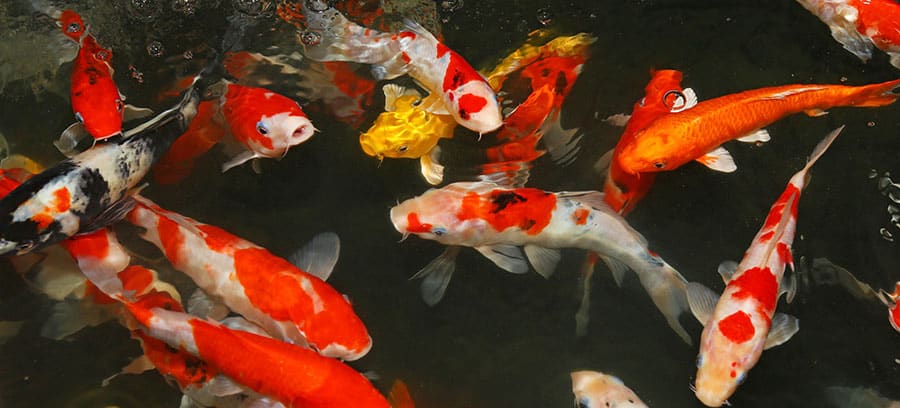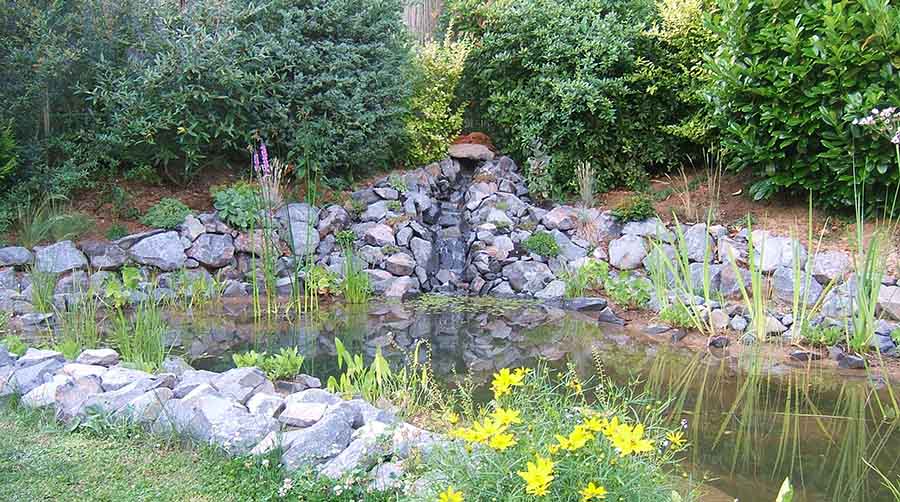Ponds are a great addition to any backyard. Whether you have a small, decorative pond or a fully stocked fishpond, you and your guests can spend hours enjoying this natural feature. One of the most important aspects of a pond is its depth. You may not know how deep to dig your pond or even if your existing pond is too deep.
Your pond may be too deep if you’re trying to grow vegetation or attract wildlife to your area. Deep ponds may be good for large fish but they’re not good for plants or animals that feed off a pond. It depends on what type of pond you want to adapt.
There are ponds for every taste and this article will let you know how deep to build a pond to suit your needs, whatever they may be. Keep reading to find out all about a pond’s necessary depth.
How Deep Should Your Pond Be?
How deep your pond should be depends on the reason you have a pond in the first place. For instance, a Koi pond should be much shallower than a fishing pond with trout. Weather also plays a part in how deep your pond should be. If you live in an area that gets very cold in the winter, that will affect how deep you need to dig your pond.
Here are a few types of ponds and how deep they should be dug.
Koi Ponds

Koi can grow to be 2 feet in length. Your pond doesn’t have to very deep for koi but it should have enough surface area for them to grow into the space.
The minimum depth for koi ponds should be 4 feet if you live in a warmer climate. If you live in a colder climate, you may want to dig your pond as deep as 21 feet. This gives the koi a place to gather in the colder months.
The main requirement for koi ponds is that the water is deep enough not to freeze during winter. A layer of ice over your pond will kill koi during winter months. It also needs to be deep enough to deter predators, which is why you need a minimum of 4 feet.
In temperate zones, a depth of 8 feet may be preferable for the koi.
Goldfish Ponds
Goldfish ponds can be as deep as koi ponds but goldfish only need a minimum of 2 feet in warmer climates. Goldfish ponds also double as water gardens since the pond is so shallow. You can put vegetation in a water garden along with the fish.
For cooler climates, you will need to make sure the goldfish have around 16 inches below the freeze zone. Be aware that predators can get to your goldfish with shallow water. You can help avoid this by making the banks as steep as possible.
Wildlife Pond

A wildlife pond is another fairly shallow pond. You can have fish in a wildlife pond but fish can be detrimental to other wildlife such as frogs or salamanders.
For these ponds, you will need a depth of 6 inches to 4 feet, although you can have some deeper areas within the pond to try to inhibit plant growth. By inhibiting vegetation in part of the pond you give wildlife like ducks a place to land on your water.
Vegetation normally found in wildlife ponds include:
- Cattails
- Bulrushes
- Pondweed
In a wildlife pond, you’re trying to attract as many animals as you can. It’s a scenic ecosystem you can enjoy year-round. Animals that are mainly attracted to a wildlife pond include:
- Ducks
- Geese
- Songbirds
- Wading birds
- Frogs
- Toads
- Lizards
- Snakes
You can also attract other mammals and amphibians in your wildlife pond. You don’t want to load up a wildlife pond with fish because the majority of the water will not be deep enough for them.
To help the wildlife coming to your pond you can decrease the slope leading into the pond, letting animals have an easier time of getting down to the water.
Warm Water Fishpond
When the pond is larger than the backyard koi or goldfish pond, many people stock it with warm water fish. Typically, these type ponds are at least a half-acre in surface area. These include:
- Bass
- Catfish
- Crappies
- Sunfish
- Bluegills
These are hardy types that can last through winters as well as other seasons. The minimum depth for building your pond for warm water fish is 10 feet. You can have shallower areas in this pond but make sure about 50 percent of your pond is this deep.
To survive, the fish need oxygen and a range of temperatures. A pond at this depth allows the fish a cooler area in which to swim during the summer. To thrive, these type fish need oxygen at 2 or 3 parts per million (ppm) levels and need temperature around 80 degrees.
Cold Water Fishpond
Coldwater ponds are normally found in the northern part of the country, where deep ponds can retain the cool temperatures cold water fish need. Coldwater fish consist mainly of trout and include:
- Rainbow trout
- Brown trout
- Brook trout
- Steelhead
The water in a cold-water pond is best maintained at 50 or 60 degrees Fahrenheit. The oxygen level needs to be around 5PPM. For the depth, you need to plan at least 12 feet so that the temperature the fish need can be maintained.
Just as in a warm water pond, it may be good to have shallower depths to your pond. A shallow depth allows sunlight to penetrate the bottom of the pond and vegetation to grow. These shallow areas can be good for a fish’s bedding area, but the deep water is needed for the overall survival and health of the fish.
Helpful Tips About Your Pond
While the maximum depth of your pond is important, remember that the area of your pond is important as well. Here are some general guidelines to follow when choosing:
- If your pond is 4 feet deep, it should be at least 8 feet long
- If your pond is 8 feet deep, the surface area should be at least 12 feet in surface area
- If your pond is 21 feet deep, it should be at least 17 feet long
Again, it’s a good idea to have differing depths in your pool, even with a shallow goldfish pond. The various depths will be used in many ways by fish and wildlife. Fish will use the deeper areas to remain cool during water or to escape predators. They can use shallow areas as bedding sites or production sites.
Here are other helpful tips for your pond:
- Many ponds with a sloped edge use either a 2:1 or a 3:1 slope. This means it should slope down 2 to 3 feet for every 1 foot of depth
- Sloped edges are not good if you want to deter predators such as raccoons. In that case, consider a sharp initial drop-off of 18 inches from the edge of the pond
- Make sure your pond is deep enough so that it doesn’t dry up during summer
- Vegetation around the edges of your pond prohibits soil erosion
- Oxygen becomes scarcer the deeper the pond is. Consider using an aerator to pump oxygen into deeper ponds
- Try not to have over-hanging tree limbs over your pond
Conclusion
Ponds can be a scenic, peaceful area for you and your family to relax and enjoy nature. However, it is vitally important you get the depth of the pond right for both fish and wildlife. Spend some time researching before you commit your time and money. Enjoy.

